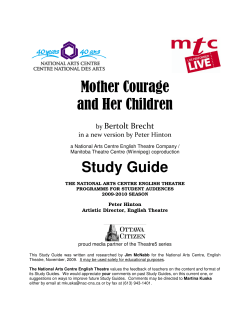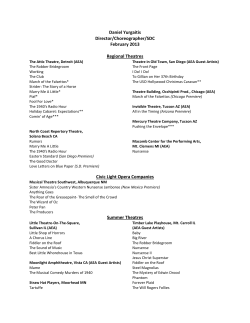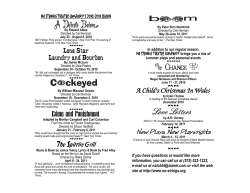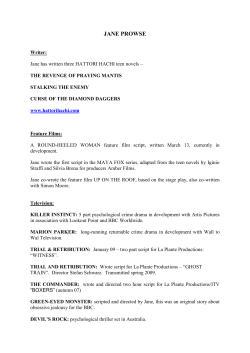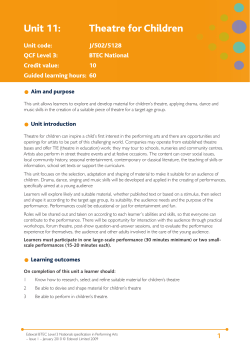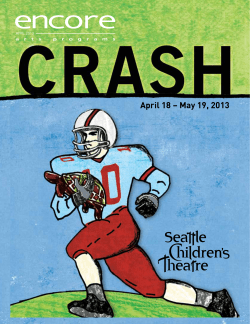
Yes, Virginia, There Is A Santa Claus
Yes, Virginia, There Is A Santa Claus -Study GuideProfessional Actors: Noel Holland as “Shirley” and Don Gruel as “Frankie” Please use this Study Guide to enhance your educational experience. ALL ABOUT A.C.T. For Youth A.C.T For Youth is an acclaimed professional touring theatre company based in Orlando, FL. Each year, the Atlantic Coast Theatre performs more than 300 shows for over 100,000 students. ACT For Youth’s high-quality educational programming is recognized nationally by theatres, schools, art councils, libraries, and festivals... not to mention the thousands of children & families who see A.C.T. shows each year! The theatre has been awarded placement on: ~2006-2008 Florida State Touring Roster~ ~Hillsborough County Artist Roster~ ~Broward County FL Artist Roster~ ~SC Arts Commission Roster Of Approved Artists~ ~Raleigh/Wake County, NC United Arts Roster~ Visit Our Website! www.atlantic-coast-theatre.com All About The Actors Noel Holland & Don Gruel You will be seeing professional actors! That means they act for their jobs! An interesting fact about the actors: They started acting when they were YOUR age! NOEL HOLLAND– HOLLAND I cannot remember a time when I was not singing. As a child, I would sing to anyone who would listen– if nobody was there to hear, I would sing to myself! I started acting and dancing because I loved performing on stage. My sister and I would put on plays for our parents in the living room! When I was in middle school and high school, I decided that I wanted to be a performer. After I graduated college with a degree in music, I became a professional actor- working for theatres all over the country. Now, I have my dream job– owning a theatre. I am so proud to be a part of the Atlantic Coast Theatre For Youth. It gives me all kinds of opportunities to sing, act, write songs, and use my imagination. I so enjoy creating shows that children love because I loved theatre and music so much when I was a child! Don as the Easter Bunny in his 3rd Grade School Play Noel & her little sister, Meredith, putting on a play for family. DON GRUEL– GRUEL I grew up in Beaufort, South Carolina. When I was little, I would make up plays using my “Star Wars” Action Figures as the actors. I started doing school plays when I was in Kindergarten, but my first play outside of school I was in the musical OKLAHOMA when I was 10 years old. I really liked the feeling of being able to pretend to become other people in other places. I kept doing plays throughout Middle School & High School and decided to study Theatre in college. I graduated from the University Of South Carolina in 1993 and have worked in professional theatre ever since. I have always loved using my imagination. As an actor, I get to be creative every single day. You can try acting too! Get involved in a play at school or in your community! BACKGROUND ON THE SHOW You will be watching a live theatre production called Yes, Virginia, There Is A Santa Claus. Yes, Virginia, There Is A Santa Claus was inspired by a real editorial written by Francis P. Church. Although the letter and its response was published in The New York Sun in 1897, our play is set in 1947. Use Your Imagination! Playwrights use their imaginations when writing a play. Our play, was inspired by a famous editorial. The playwright used his imagination to write a new play! He set the play in 1947, wrote brand new characters, weaved a storyline, and created a script to fit his ideas. Find a real story from history that inspires you! Use your imagination to think of a brand new way to tell that story. Write a paper or even a play! Remember to be creative! Sometimes stories from history are the BEST inspirations. Virginia O’HanlonVirginia O’Hanlon was born in 1889, and was 8 when she wrote the New York Sun her famous letter. Her family had a tradition of writing the paper when they had questions. Little did she know, but her letter would be published eventually in papers all over the world! People started writing letters to her too! In fact, she received letters for the rest of her life regarding this article! When Virginia grew up she became a school teacher with the New York City School System. Eventually she became a principal– working as an educator for 47 years. Virginia believed that her letter and its answer shaped the direction of her life. She died in 1971. Francis P. Church– Church Francis P. Church was born in 1839. In his younger years, he wrote as a war correspondent during the Civil War. Church’s brother, William, owned The New York Sun, where Francis worked as an editor for 20 years. Virginia’s letter, and his response became an immediate sensation. It is actually one of the most famous editorials ever written. Church married after the article was printed, but died a few years later in 1906. This article was reprinted in The New York Sun annually until the paper went out of business in 1949. It is still famous and cherished today. Why Did A.C.T For Youth Set The Play In 1947? Many of the most cherished and loved holiday movies were released in 1946 and 1947– right after World War II which ended in 1945. Some movie critics believe that moviegoers were looking for inspiring and uplifting movies to help heal their weary hearts from the war. The movie studios created many lovely and meaningful pictures during this time. These were Black-and-white movies like: It’s A Wonderful Life (1946) Miracle On 34th Street(1947) The Bishop’s Wife (1947) These movies have stood the test of time- filling modern families homes with holiday cheer every year. Many families have traditions of watching these movies during the season. A.C.T. For Youth’s production of Yes, Virginia, There Is A Santa Claus was inspired not only by the historical editorial but also by many of these beautiful black-and-white holiday pictures from the late 1940’s. You will notice that all of the set and costumes in the play are shades of white, black, and grey. Why is that? Well, the decision to use those colors is what many theatre professionals call an “artistic choice”. The Atlantic Coast Theatre wanted to have the “feel” of the black and white movies even though is was a play. The Bishop’s Wife How are the styles of clothes and hairstyles different in 1947 than they are today? Compare and contrast how cars looked in 1947 and how they look today. These are photographs from New York City in the 1940’s. Does NYC look different now? These words are used during the play. You may not be familiar with all of them. Use the back of this page or your own paper to write a sentence using each word. Central Park– A famous public park located in the middle of New York City. The New York Sun– A morning newspaper that started in 1833 and ended in 1950. Now, there is a new New York Sun paper that started in 2002. Times Square– A major intersection in Manhattan in New York City. Many celebrations have been held here throughout New York City’s history. Brooklyn– One of 5 boroughs (major neighborhoods) of New York City. Gimbels– A famous department store in New York City during the 1940’s. The store had a long standing rivalry with Macy’s department store. Gimbel’s New York location closed in 1987. Fountain Pen– An old fashioned writing pen that holds liquid ink inside the pen. The ink is released through a sharp point when you write. The fountain pen fell out of fashion and was eventually replaced almost exclusively by the modern ballpoint pen, which was developed in 1938. Jazz– A musical art form that uses improvisation. Many popular singers during the 1940’s sang jazzy tunes. Sometimes jazz from the 1940’s is called “Swing”. Editorial– An article in a newspaper that expresses the opinion of one of the editors. The editor at a newspaper looks over the articles and makes changes or corrections before the paper goes to print. The job of an editor is sort of like your teacher’s job when he/she grades your papers. Fact– Something known and proved to be true. Plagiarize– To use and pass on someone else’s writing or ideas as your own. Deadline– The time when an assignment must be finished. Before The Show Activities • • • You will be seeing a live theatre production. What are the differences between a play and theatre or TV? What kinds of theatre manners should be used when watching a play? The play is set in the 1940’s. Look over the pictures on the “1947– How It Looked” page of the study guide. Talk about how the pictures compare and contrast to today’s styles. There are a few words used in the show you may not know. Try to become familiar with the vocabulary words listed in the study guide. After The Show Activities • • • • As a class discuss the historical background of the editorial “Yes, Virginia, There Is A Santa Claus”. How is the event from history different from the play? Frankie loved his fountain pen. It was special to him, even though the newer ballpoint pens might have worked better. What is a special possession that you have that means more to you than it would to others? Have everyone in the class bring in their special possession & share why it is important to them. Shirley has dreams about being a jazz singer. She works hard auditioning for jobs, and eventually it pays off when she sings in Times Square. In life, if we want to achieve our dreams, we must work very hard. What are your dreams? What would be your dream job when you grow up? It’s never to early to start reaching for your dreams. What are some realistic steps that you could take right now to help you get to your goals? Write them down, and start to do them. Be A Reporter! You don’t have to work for a boss like “Crabby Curtis” to be a reporter. Investigating and learning new things is fun! Pick one topic about New York City from the list below– learn as many F-A-C-T-S as you can and write an article about them. Be sure to report the WHO, WHAT, WHEN, WHERE, WHY, and HOW. You can even compile everyone’s articles and make a class newspaper! EMPIRE STATE BUILDING ~BROOKLYN BRIDGE ~BROADWAY ~CENTRAL PARK ZOO ~MUSEUM OF NATURAL HISTORY ~METROPOLITAN MUSEUM OF ART ~LITTLE ITALY ~GREENWICH VILLAGE ~NY CHINATOWN ~NEW YORK SUBWAY ~HUDSON RIVER ~STATUE OF LIBERTY ~ELLIS ISLAND ~NEW YORK YANKEES A.C.T. For Youth loves to receive letters from our audience! Here Are A Few Things You Can Include In Your Letter! ~A DRAWING~ ~WHAT YOU LEARNED~ ~YOUR FAVORITE PART~ Your Opinions Count! They Help Us When We Write New Shows! You will write letters all of your life– in school, to correspond with friends and family, and for your job one day. It is very important to know how to write a good letter. Your teachers may want you to write your letter in a proper letter-writing style or format. Here is an example of one style! A.C.T. For Youth 8297 Champions Gate Blvd. #188 Champions Gate, FL 33896 Dear Audience: The Atlantic Coast Theatre For Youth would like to thank all of you for showing us such fantastic audience manners during the show! Everyone was so respectful during the performance. You laughed when things were funny, but you were also able to quiet back down so that everyone could hear. I don’t think that we heard anyone talking while the actors were on stage. That was great! You made our job so much fun. Thanks so much! You were wonderful! Sincerely, Don Gruel & Noel Holland Send your letters to: Atlantic Coast Theatre For Youth 8297 Champions Gate Blvd. #188 Champions Gate, FL 33896 Yes, Virginia, There Is A Santa Claus National Standards: Kindergarten – 4th Grade (By participating in the Study Guide activities, watching the performance, and encouraging classroom discussion of the play, your students can meet aspects of several National Education Standards) NA-T.K-4.6 COMPARING AND CONNECTING ART FORMS BY DESCRIBING THEATRE, DRAMATIC MEDIA, AND OTHER ART FORMS • Students describe visual, aural, oral, and kinetic elements in theatre, dramatic media, dance, music, and visual arts • Students compare how ideas and emotions are expressed in theatre, dramatic media, dance, music, and visual arts NA-T.K-4.7 ANALYZING AND EXPLAINING PERSONAL PREFERENCES AND CONSTRUCTING MEANINGS FROM CLASSROOM DRAMATIZATIONS AND FROM THEATRE, FILM, TELEVISION, AND ELECTRONIC MEDIA PRODUCTIONS • Students explain how the wants and needs of characters are similar to and different from their own • Students articulate emotional responses to and explain personal preferences about the whole as well as the parts of dramatic performances NA-T.K-4.8 UNDERSTANDING CONTEXT BY RECOGNIZING THE ROLE OF THEATRE, FILM, TELEVISION, AND ELECTRONIC MEDIA IN DAILY LIFE • Students identify and compare similar characters and situations in stories and dramas from and about various cultures, illustrate with classroom dramatizations, and discuss how theatre reflects life • Students identify and compare the various settings and reasons for creating dramas and attending theatre, film, television, and electronic media productions NA-M.K-4.9 UNDERSTANDING MUSIC IN RELATION TO HISTORY AND CULTURE • Students demonstrate audience behavior appropriate for the context and style of music performed NSS-USH.K-4.1 LIVING AND WORKING TOGETHER IN FAMILIES AND COMMUNITITES, NOW AND LONG AGO • Understands family life now and in the past, and family life in various places long ago NSS-USH.K-4.4 THE HISTORY OF PEOPLES OF MANY CULTURES AROUND THE WORLD • Era 7: The Emergence Of Modern America NL-ENG.K-12.2 UNDERSTANDING THE HUMAN EXPERIENCE Students read a wide range of literature from many periods in many genres to build an understanding of the many dimensions of human experience Yes, Virginia, There Is A Santa Claus National Standards: 5th Grade (By participating in the Study Guide activities, watching the performance, and encouraging classroom discussion of the play your students can meet aspects of several National Education Standards) NA-T.5-8.6 COMPARING AND CONNECTING ART FORMS BY DESCRIBING THEATRE, DRAMATIC MEDIA, AND OTHER ART FORMS • Students describe characteristics and compare the presentation of characters, environments, and actions in theatre, musical theatre, dramatic media, dance, and visual arts • Students express and compare personal reactions to several art forms • Students describe and compare the functions and interaction of performing and visual artists and audience members in theatre, dramatic media, musical theatre, dance, music, and visual arts NA-T.5-8.7 ANAYZING AND EXPLAINING PERSONAL PREFERENCES AND CONSTRUCTING MEANINGS FROM CLASSROOM DRAMATIZATIONS AND FROM THEATRE, FILM, TELEVISION, AND ELECTRONIC MEDIA PRODUCTIONS • Students describe and analyze the effect for publicity, study guides, programs, and physical environments on audience response and appreciation of dramatic performances NA-T.5-8.8 UNDERSTANDING CONTEXT BY RECOGNIZING THE ROLE OF THEATRE, FILM, TELEVISION, AND ELECTRONIC MEDIA IN DAILY LIFE • Students describe and compare universal characters and situations in dramas from and about various cultures and historical periods, illustrate in improvised and scripted scenes, and discuss how theatre reflects a culture NSS-WH.5-12.7 ERA 7: AN AGE OF REVOLUTIONS (1830-1914) NSS-USH.5-12.7 ERA 6: THE DEVELOPMENT OF THE INDUSTRIAL UNITED STATES • Understands massive immigration after 1870 and how new social patterns, conflicts, and ideas of national unity developed amid growing cultural diversity NL-ENG.K-12.2 UNDERSTANDING THE HUMAN EXPERIENCE Students read a wide range of literature from many periods in many genres to build an understanding of the many dimensions of human experience ATLANTIC COAST THEATRE FOR YOUTH Yes, Virginia, There Is A Santa Claus Florida Sunshine State Standards: Pre-K-2nd Grades (By participating in the Study Guide activities, watching the performance, and encouraging classroom discussion of the play, your students can meet aspects of several standards) THEATRE TH.A.1.1 The student acts by developing, communicating, and sustaining characters in improvisation and formal or informal productions Creates imagined characters, relationships, and environments using basic acting skills Creates individually and in groups, animate and inanimate objects through the movement of the human body TH.C.1.1 The student understands context by analyzing the role of theatre, film, television, and electronic media in the past and present Expresses remembered ideas, feelings, and concepts of daily activities through dramatic play Understands how we learn about ourselves, our relationships, and our environment through forms of theatre Understands characters, situations, and dramatic media from the stories and dramas of various cultures TH.D.1.1 The student analyzes, criticizes, and constructs meaning from formal and informal theatre, film, television, and electronic media Portrays imaginary sensory experiences through dramatic play Gives reasons for personal preferences for formal and informal performances Understands appropriate audience responses to dramatic presentations Understands how theater communicates events of everyday life Understands the similarities and differences between play acting, pretending, and real life TH.E.1.1 The student understands applications of the role of theatre, film, television, and electronic media in everyday life Understands the similarities and differences among how emotions are expressed in theatre, dramatic media, music, dance, and visual art Cooperates with others to create formal and informal theatrical works and to solve the problems inherent in simple scenes MUSIC MU.D.1.1 The students listens to, analyzes, and describes music Understands how music can communicate ideas suggesting events, feelings, moods, or images MU.E.2.1 The student understands the relationship between music and the world beyond the school setting Knows appropriate audience behavior in a given music setting LANGUAGE ARTS LA.C.1.1 The student uses listening strategies effectively Listens for a variety of informational purposes, including curiosity, pleasure, getting directions, performing tasks, solving problems, and following rules Recognizes personal preferences in listening to literature and other material Retells specific details of information heard, including sequence of events LA.E.1.1 The student understands the common features of a variety of literary forms ATLANTIC COAST THEATRE FOR YOUTH Yes, Virginia, There Is A Santa Claus Florida Sunshine State Standards: 3rd-5th Grades (By participating in the Study Guide activities, watching the performance, and encouraging classroom discussion of the play, your students can meet aspects of several standards) THEATRE TH.A.1.2 The student acts by developing, communicating, and sustaining characters in improvisation and formal or informal productions Creates imagined characters, relationships, and environments using basic acting skills TH.C.1.2 The student understands context by analyzing the role of theatre, film, television, and electronic media in the past and present Understands how theatre is an interpretation of actual events in history and everyday life Understands how theatre reflects culture through universal characters and dramas from various cultures and historical time periods TH.D.1.2 The student analyzes, criticizes, and constructs meaning from formal and informal theatre, film, television, and electronic media Knows how theatre uses visual elements (e.g. set design and costuming), sound (e.g. sound effects and vocal inflection), and movement (e.g. staging and character portrayal) to communicate Understands the similarities and differences between real life and the theatre’s representation of life (e.g. the meaning of the concept, “willing suspension of disbelief”) Articulates emotional responses to the whole, as well as parts of, dramatic performances TH.E.1.2 The student understands applications of the role of theatre, film, television, and electronic media in everyday life Understands theatre as a social function and theatre etiquette as the responsibility of the audience Collaborates in the construction of formal and informal productions MUSIC MU.E.2.2 The student understands the relationship between music and the world beyond the school setting Knows and applies appropriate audience behavior in various musical settings LANGUAGE ARTS LA.C.1.2 The student uses listening strategies effectively Listens and responds to a variety of oral presentations, such as stories, poems, skits, songs, personal accounts, and informational speeches Identifies specific personal listening preferences regarding fiction, drama, literary nonfiction, and informational presentations LA.E.1.2 The student understands the common features of a variety of literary forms Identifies the distinguishing features among fiction, drama, and poetry and identifies the major characteristics of nonfiction Understands the development of plot and how conflicts are resolved in a story
© Copyright 2025
